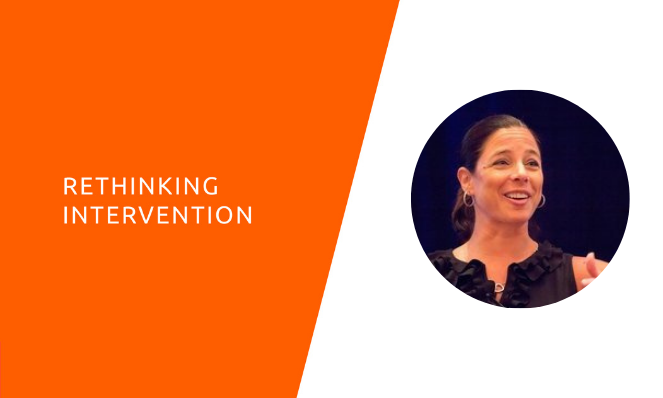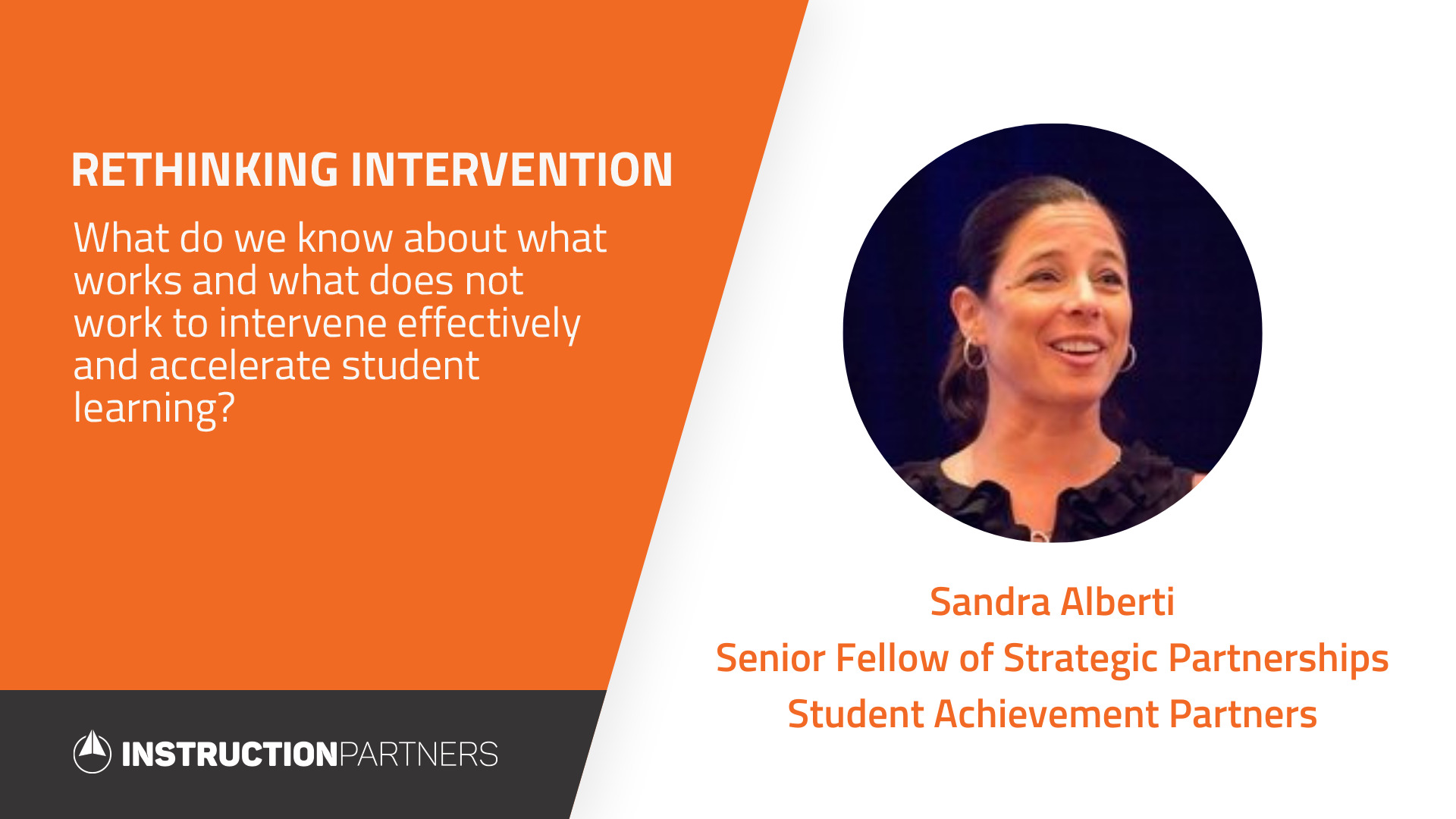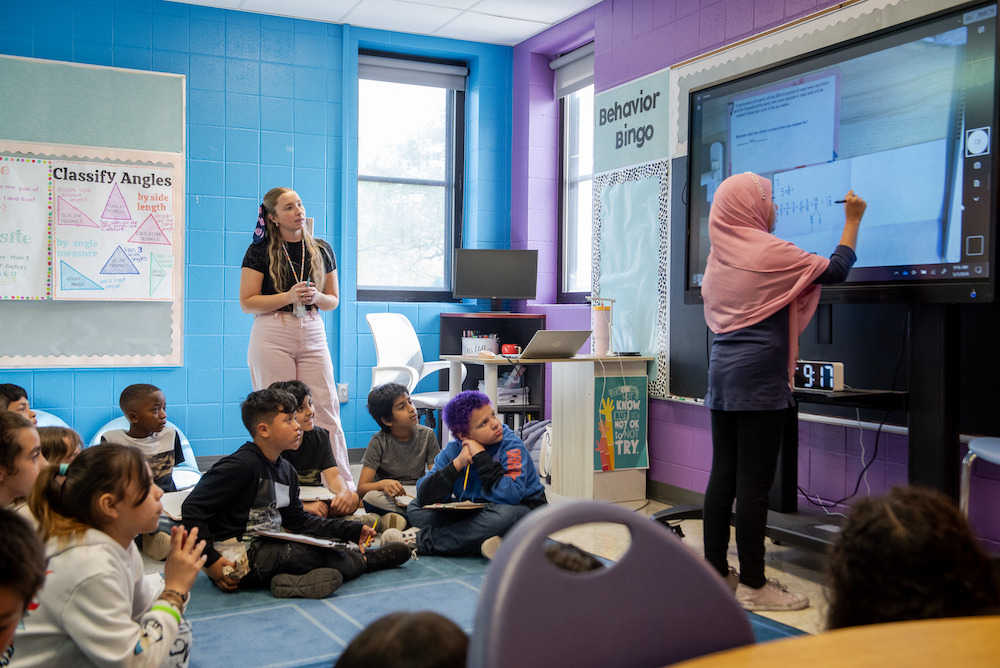
Sandra Alberti, Student Achievement Partners
Sandra Alberti is Instruction Partners’ Board Chair and the Senior Fellow, Strategic Partnerships at Student Achievement Partners (SAP). She joined SAP from the New Jersey Department of Education where she served as the Director of Academic Standards and as the Director of Math and Science Education.
Sandra spoke with Emily Freitag about the task of supporting student learning in the wake of disrupted schooling. This conversation took place on May 29, 2020.
Watch the full conversation or read the abridged Q&A below.

EF: Tell us your story as a learner and what that has taught you about learning.
SA: In reflecting on this, my first reaction is that I don’t think my story is super interesting. If I reflect back on my life as a student, I did originally think about learning as task-completion. I remember in my own formal schooling, probably not being until in mid-high school when I was like, “No, this isn’t just about completing tasks that someone assigned to you. This is actually an opportunity to reflect and learn and gain information.” Once I experienced the challenge and the opportunity to learn independently, in this particular case from text because I wasn’t going to learn from my teacher, that gave me this kind of superpower. I felt like most of my student colleagues in high school didn’t have that power of learning independently from texts that are in front of you. I challenged myself to do that in a way that wasn’t just receiving what I was given, but that there was actually an active component to it. I went from student to an adult, teacher, educator professional with this affinity for learning as, not a chore, but almost a necessary element of living. I feel fortunate to have a good experience in being able to do that and feel fortunate in my position at Student Achievement Partners. I know that that is a huge part of what we intend for students. The experience that we hope for students that it’s not just completing a set of tasks, even being on task, but that students are actually engaged actively in ways that cause them to think and learn, not just complete and move on. That joy of self-directed learning is part of what I thought about.
EF: It sounds like it’s both the ability to learn independently from text and from reflection.
You have held many roles in education: teacher, principal, system leader, state leader, now school board chair, and you work at Student Achievement Partners. SAP includes a team of many individuals who have played important roles in the development of the standards and the support around the standards. So, from those experiences, share with us any thoughts you have on what we know works in the act of learning.
SA: I do think that there is this consistent drumbeat about belief in students and clarity around expectations. We need to know: What is it that the standards expect? Is it clear? Do we know what it looks like in practice? Do we have resources to support it? But if underlying there is a conscious, or more likely unconscious, disbelief that students can achieve, I don’t know that the greatest set of resources are going to get us where we need to go. I really see this idea of “what works” as starting with what is easily said, but not often deeply examined: The belief that all students deserve a high-quality education. That all students, with the appropriate support, belief, and encouragement, deserve a place where they feel valued and they feel respected.
Often, we think about these things in two separate buckets. For relationships, people have gone down the route of personalization, and I think that has all been very misconstrued or misrepresented because it has always been presented as a separate service. The kids can feel engaged, that they feel that they can belong—all of that is really in service to providing students access to excellent instructional opportunities and things that they are actually able to excel in. I think we have work to do in respecting students and respecting where they come from, what assets they bring. Particularly with students who are most often at the margins, even if it’s well-intentioned, most often we do things that actually prevent them from feeling valued, from being respected, from being able to excel in the things that will make the biggest difference for kids, in their lives as students, and then their lives beyond that. This may sound odd coming from Student Achievement Partners where we talk about math and literacy standards. The standards themselves never have been and never were what helps students. They create a roadmap that then requires a lot of work. And the more I think about this, the more I think about the role of teacher and student identity as being a critical component in this work.
EF: You started to talk a little bit about some of the things that we do that actually don’t work. Can you go into more detail?
SA: In literacy, obviously one of the things that, pre-, I’ll just say pre-college and career-ready or Common Core, we paid little attention in the policy documents of standards to what students were reading. I know in my own role at the State Department in New Jersey, I knew that the experience of a literacy education in Newark, New Jersey was very different than what was marking the experiences and the texts and the authors and the kinds of conversations that were being had in other school districts in the state. Not to say that one was better or one was worse. I mean, we had rich conversations. For what isn’t working, I think often we create ceilings, particularly for kids that we worry most about. We don’t expose them to quality texts. There’s a lot of concern right now when it comes to what kids are reading and really pushing into very important issues of culturally-responsive texts. There are challenging, quality, grade-level texts that we owe it to every student in America to have access to.
I think from good intentions, from prior practice that we’ve been taught or we’ve been reinforced, there has been this notion of an avoidance of struggle—thinking that if we ask too much of students they’re going to be disengaged and not want to do more. From the very beginning, I remember most clearly when we started talking about “Letter From a Birmingham Jail,” thinking about kids who never engaged in that level of text-based conversation that just blew teachers away. They never anticipated that students would engage at that level. Oftentimes, before students even have a shot at being exposed to grade-level material, we already make judgments about what they can and can’t do.
Similarly in math, we’re at a place now in the year 2020 where we have more opportunities to engage in quality math tasks that are more available than they’ve ever been before. However, even in places where you know the books or worksheets in front of kids include some of those tasks, we see teachers undercutting them by eliminating this requirement or changing this piece of vocabulary. We’re not expecting as much out of these students without even giving them a shot. A very often-had conversation, particularly in the world of high-quality instructional materials is “Well, what can my kids do versus what opportunities can I provide my students that sets this kind of expectation?”
EF: Let’s dig into assessment, something I know that you’ve been thinking a lot about. What are the best practices and malpractices?
SA: Of course, a lot of our thoughts and actions lately are inspired by the COVID home/online-learning situation. We’re now at the end of May and already anticipating the challenges that we’ll be facing within the upcoming school year, if not school years. And there are certainly exacerbated issues. I don’t want to belittle those at all. But there are also some realizations that things that weren’t working well before—and now we have a brighter light on those things.
This notion of assessments of various types is super important now, we believe that data is important, and who needs to know what information is certainly part of this conversation. Oftentimes, when we think about assessment practice, we think about two things that concern me. One is how we use assessments to label and sort kids, which isn’t always what is most helpful. And two is how we use assessments to identify students’ deficits rather than using assessments to identify students’ strengths.
What I feel very strongly about, and I won’t say this is the official SAP position—this is a Sandra Alberti position—is that coming back to this school year, students have experienced education in a huge variety of ways. Everything from having parents shoulder-to-shoulder supporting their learning with students, identifying their own interests, and really quite frankly, excelling in this kind of a structure, to students who are left independent either as a function of the school district and community that they live in or within a supportive community as a function of the household that they live in. It’s super troubling. So, I feel like there is an ongoing, kind of instinctual need to say that the first order of business needs to be “Let’s figure out where kids are when they come to us.” And I worry tremendously about two aspects of that idea. One is that when we are judging students where they are and how much learning they lost, we’re not just judging the students, that we’re judging their home situation. And then two, that when we’re finally back into it, that the first thing that we do is label and sort kids versus building community and building connections in schools, which I just think is going to be critically important this fall.
That being said, we have a lot of different ideas about what do we need. Student Achievement Partners just published Priority Instructional Content for math and for literacy. We’re looking at the priority standards that we think are absolutely important to support grade-level instruction. The big fear is this notion of prerequisite, that if you don’t pass a certain set of knowledge and skills from the prior year, that you’re not going to be able to access grade-level. And quite frankly, that would just set us back at least 10 years of work that many school leaders have really been executing on in a very powerful way of late.
We feel the best form of assessment for the year ahead is going to be an integrated assessment system. You won’t know anything better about where your kids are and what they need than you will find out from formative, teacher-lead checks for understanding and conversations. This is in contrast with very disconnected from the curriculum, disconnected from instructional information assessment that just gives you a score and leads to sorting and labeling of kids, but does not help in any way to support student learning. For any kind of assessment, whether it’s formative or no benchmark kind of interim testing, that it is absolutely instructionally relevant is the most important thing, because we’re going to open this world of differentiation and scaffolding necessary in the upcoming year in a way that we haven’t done before. Kids are going to need more scaffolds. And we are not aware of many formal assessment programs that provide that kind of information. Quite frankly, I think we do know that formative integrative assessment is probably the best thing a teacher can do, for social reasons as well as for instructional planning.
The other word that I hear bantered around quite a bit lately is this need to “diagnose.” I had the good fortune in my state education job to work with an amazing psychometrician and every time I even said “diagnose,” he would make sure I knew exactly what that meant. It’s not just asking one question. There’s a sophistication to diagnosing anything. What we are best served to do right now is not to think about diagnosing individual kids, but diagnosing: What is our instructional plan in the subject area, in a grade-level, in a school system? How do we diagnose where our community is right now? What do they need? Versus this notion of a diagnostic plan for every individual kid. I just don’t think it’s going to serve us well considering time, resources, and relevancy to the work that we have in front of us.
EF: Tell us what else you think educators should be keeping top of mind as they think about the job ahead.
SA: I worry tremendously that anybody thinks that next year is going to be anything like the years that we’ve had before. There’s been a lot of energy about saying, “It will never be the same again.” And nor should it, because boy have we learned so much about inequities in the system. We’ve learned so much about different students having different learning styles. You mentioned that I sit on a local school board. You know, for everything that we can find people that hate, we can find other students who love those same things. And it’s interesting because we’re taking that input and that feedback now in ways that we never did with, we’ll just say, “traditional school.” But I’m sure with everything we did, traditionally, you could find some families who loved it, and some families and students who hated it. We just feel like we have more voice and say right now, and I think that’s important to think about what we learned in that way as well.
The other lesson that I hope beyond hope that we can really hold on to through this experience is this opportunity that we’ve all experienced to rapidly look for solutions to very tough problems, to try something out, get some feedback on it, and iterate on it. That’s what learning is all about. I think we’ve gotten into the decades-old habit of thinking that we always need to lead with the perfect answer, with the perfect plan, that this can’t be messy. We can’t show our vulnerabilities and say “Here’s something I’m exploring. Here’s something that I need to know.”
We would have never gotten as far as we’ve gotten in the last two+ months if we let perfection prevent acting quickly. We’ve seen leaders who are natural learners, who don’t shy away from their vulnerabilities and their opportunities to learn, really lean into the opportunity to learn and innovate right now. And those who are very much about the, “I only put out packages that are tied neatly with the bow and everything is controlled and predicted” are really having trouble getting out of the starting blocks in this place. Once everybody’s back in school structures, I hope that we think about some of the problems that we actually thought were immutable. I hope we think about some things that we might engage together to try to learn from so that we can start moving a little faster toward improvement in our profession than we have done in the past.
EF: That resonates. I think this Rethinking Intervention series is exploring questions that we might all feel like we should have the answers to. And yet, what stalled us from talking about this, in the same way, a year ago?
Is there anyone else we should be learning from?
SA: There’s lots of great work being done. People need to be inspired by people who are leaning into this work and seeing what’s possible. As educators, this is an opportunity to learn. We should value that and not rush that and allow ourselves to gain from it.


